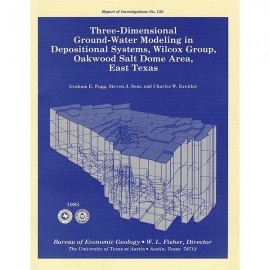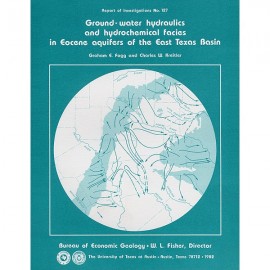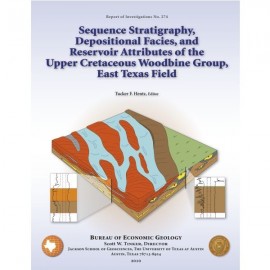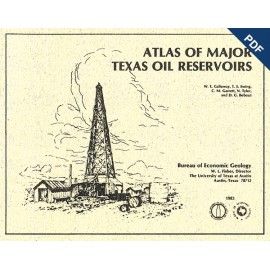Geological Circulars
-
Books & Reports
- Reports of Investigations
- Guidebooks
- Udden Series
- Geological Circulars
- Down To Earth
- Atlases of Major Oil and Gas Reservoirs
- Texas Memorial Museum Publications
- Environmental Geologic Atlas of the Texas Coastal Zone
- Mineral Resource Circulars
- Other Reports
- Seminars and Workshops
- Handbooks
- Submerged Lands of Texas
- Symposia
- Annual Reports
- Open File Reports
-
Maps & Cross Sections
- Thematic Maps
- Miscellaneous Maps, Charts & Sections
- Geologic Atlas of Texas
- STATEMAP Project Maps
- Geologic Quadrangle Maps
- Cross Sections
- Highway Geology Map
- Energy and Mineral Resource Maps
- Shoreline Change and Other Posters
- Wilcox Group, East Texas, Geological / Hydrological Folios
- Bouguer Gravity Atlas of Texas
- River Basin Regional Studies
- Featured Maps
- Posters
- Teachers & the Public
-
Geological Society Publications
- Gulf Coast Association of Geological Societies
- Alabama Geological Society
- Austin Geological Society
- Corpus Christi Geological Society
- Houston Geological Society
- Lafayette Geological Society
- Mississippi Geological Society
- New Orleans Geological Society
- South Texas Geological Society
- GCS SEPM Publications
- Historic BEG & UT Series
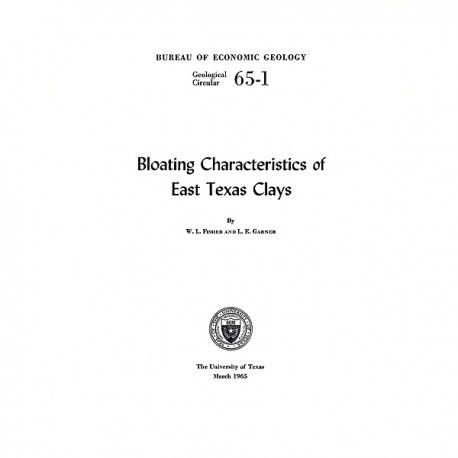
Bloating Characteristics of East Texas Clays
GC6501
A free, digital version of this publication can be found on: Texas ScholarWorks
GC6501. Bloating Characteristics of East Texas Clays, by W. L. Fisher and L. E. Garner. 20 p., 12 figs., 1965. Print.
To purchase this publicaton as a downloadable PDF, please order GC6501D.
ABSTRACT
Incidence of bloating among approximately 600 clay samples from East Texas, ranging in age from Gulfian (Late Cretaceous} to Recent, correlates principally with clay mineralogy-and pH--together an indication of bulk composition--and to a lesser extent with texture, loss on ignition, and content of nonclay refractory minerals. Clay-mineral and pH data permit prediction of bloating with an accuracy of about 80 percent. Montmorillonitic and illitic clays are the best bloaters; bloating occurs in more than 80 percent of clays consisting of less than 30 percent kaolinite, more than 10 percent illite, and between 20 and 90 percent montmorillonite. Only 10 percent of the high-alumina clays (more than 50 percent kaolinite) bloat; these generally are plastic and carbonaceous. Value of pH is an index of the amount of certain flux and gas-forming materials in clays; accordingly, bloating incidence generally increases with increase in pH. Incidence of bloating also increases slightly with decrease in grain size, increase in plasticity, increase in loss on ignition, and decrease in content of nonclay refractory minerals.
Keywords: clays, East Texas
CONTENTS
Abstract
Introduction
Acknowledgments
Sampling and testing procedures
Stratigraphic distribution
Bloating factors
Clay mineral composition
Fluxing and gas-forming components
Clay pH
Clay texture
Loss on ignition
Conclusions
References
Figures
1. Index map and distribution of clay samples
2. Stratigraphic distribution of clay samples
3. Stratigraphic variation in clay mineral composition
4. Clay mineral composition of East Texas clays
5. Correlation of bloating incidence and clay mineral composition
6. Correlation of bloating incidence and clay pH
7. Bloating incidence as a function of pH range
8. Clay mineral composition and pH of bloating and nonbloating clays
9. Correlation of bloating incidence and clay texture
10. Correlation of bloating incidence and loss on ignition
11. Fields of bloating incidence based on clay mineral composition
12. Fields of bloating incidence based on clay mineral composition and pH
Table 1. Relationship of calcium (expressed as oxide) content and bloating incidence, East Texas clays
Citation
Fisher, W. L., and Garner, L. E., 1965, Bloating Characteristics of East Texas Clays: The University of Texas at Austin, Bureau of Economic Geology, Geological Circular 65-1, 20 p.
- Author: Fisher, W. L., and Garner, L. E., 1965, Bloating Characteristics of East Texas Clays: The University of Texas at Austin, Bureau of Economic Geology, Geological Circular 65-1, 20 p.

